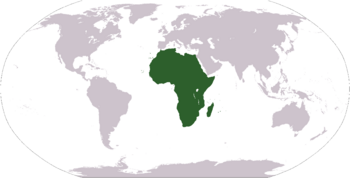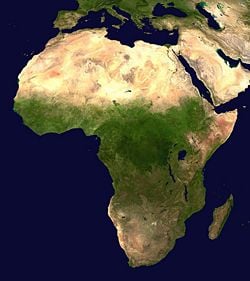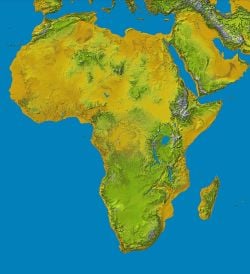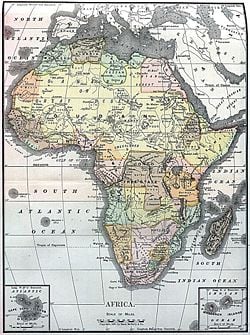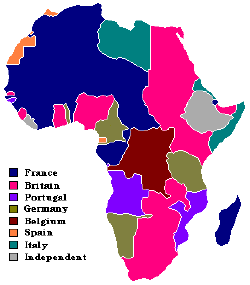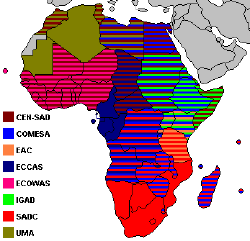Africa
Africa is the world's second-largest and second most-populous continent, after Asia. If adjacent islands are included, it covers six percent of Earth's total surface area and 20 percent of the total land area. The continent is surrounded by the Mediterranean Sea to the north, the Suez Canal and the Red Sea to the northeast, the Indian Ocean to the southeast, and the Atlantic Ocean to the west. There are 46 countries including Madagascar, and 53 including all the island groups.
Africa, particularly central eastern Africa, is widely regarded within the scientific community to be the origin of humans and the Hominidae tree, as evidenced by the discovery of the earliest hominids, as well as later ones that have been dated to around seven million years ago including Sahelanthropus tchadensis, Africanus, Homo erectus, with the earliest humans being dated to ca. 200,000 years ago, according to this view.
Afri was the name of several peoples who dwelt in North Africa near the provincial capital, Carthage. The Roman suffix "-ca" denotes "country or land." Other etymologies that have been postulated for the ancient name 'Africa':
Africa is home to some of the most remarkable natural wonders in the world. Included among them are Mounts Kilimanjaro and Kenya, the Great Rift Valley, Lakes Victoria and Tanganyika, the Niger River, Victoria Falls, the Atlas Mountains, the Kalahari and Sahara Deserts, as well as the beautiful Serengeti Plain.
Geography
At about 11,668,545 square miles (30,221,532 km²), Africa is the largest of the three great southward projections from the main mass of Earth's exposed surface. It is Earth's oldest and most enduring landmass, with most of the continent having been where it is now for more than 550 million years. Separated from Europe by the Mediterranean Sea, it is joined to Asia at its northeast extremity by the Isthmus of Suez (transected by the Suez Canal). (Geopolitically, Egypt's Sinai Peninsula east of the Suez Canal is often considered part of Africa, as well.)
From the most northerly point, Ras ben Sakka in Tunisia, to the most southerly point, Cape Agulhas in South Africa, is a distance of approximately 5,000 miles (8,000 km); from Cape Verde, the westernmost point, to Ras Hafun in Somalia, the most easterly projection, is a distance of approximately 4,600 miles (7,400 km). The coastline is 16,100 miles (26,000 km) long, and the absence of deep indentations of the shore is illustrated by the fact that Europe, which covers only 4,010,000 square miles (10,400,000 km²) — about a third of the surface of Africa — has a coastline of 19,800 miles (32,000 km).
Africa's largest country is Sudan, and its smallest country is the Seychelles, an archipelago off the east coast. The smallest nation on the continental mainland is The Gambia.
According to the ancient Romans, Africa lay to the west of Egypt, while "Asia" was used to refer to Anatolia and lands to the east. A definite line was drawn between the two continents by the geographer Ptolemy (85-165 C.E.), indicating Alexandria along the Prime Meridian and making the Isthmus of Suez and the Red Sea the boundary between Asia and Africa. As Europeans came to understand the real extent of the continent, the idea of Africa expanded with their knowledge.
Climate
Africa straddles the equator and encompasses numerous climate areas; it is the only continent to stretch from the northern temperate to southern temperate zones. Because of the lack of natural regular precipitation and irrigation as well as glaciers or mountain aquifer systems, there is no natural moderating effect on the climate except near the coasts.
The climate of Africa ranges from tropical to subarctic on its highest peaks. Its northern half is primarily desert or arid, while its central and southern areas contain both savanna plains, and very dense rainforest regions. In between, there is a convergence where vegetation patterns such as Sahel and steppe dominate.
Fauna and flora
Africa boasts perhaps the world's largest combination of density and "range of freedom" of wild animal populations and diversity, with wild populations of large carnivores (such as lions, hyenas, and cheetahs) and herbivores (such as buffalo, deer, elephants, camels, and giraffes) ranging freely on primarily open non-private plains. It is also home to a variety of jungle creatures (including snakes and primates) and aquatic life (including crocodiles and amphibians).
History
Africa is considered by most paleo-anthropologists to be the oldest inhabited territory on earth, with the human species originating from the continent. During the middle of the twentieth century, anthropologists discovered many fossils and evidence of human occupation perhaps as early as seven million years ago. Fossil remains of several species of early apelike humans thought to have evolved into modern man, such as Australopithecus afarensis (radiometrically dated to c. 3.9-3.0 million years B.C.E.), Paranthropus boisei (c. 2.3-1.4 million B.C.E), and Homo ergaster (c. 600,000-1.9 million B.C.E) have been discovered.
Throughout humanity's prehistory, Africa (like all other continents) had no nation states and was instead inhabited by groups of hunter-gatherers such as the Khoi and San.
At the end of the Ice Ages, estimated to have been around 10,500 B.C.E., the Sahara had become a green fertile valley, and its populations returned from the interior and coastal highlands in Sub-Saharan Africa. However, the warming and drying climate meant that by 5,000 B.C.E. the Sahara region was becoming increasingly dry. The population trekked out of the Sahara region toward the Nile Valley below the Second Cataract, where they made permanent or semi-permanent settlements. A major climatic recession occurred, lessening the heavy and persistent rains in Central and Eastern Africa. Since then dry conditions have prevailed in Eastern Africa, especially in Ethiopia, in the last 200 years.
The domestication of cattle in Africa preceded agriculture and seems to have existed alongside hunter-gathering cultures. It is speculated that by 6,000 B.C.E. cattle were already domesticated in North Africa. In the Sahara-Nile complex, people domesticated many animals, including the pack ass and a small goat that was common.
The first cases of domestication of plants for agricultural purposes occurred in the Sahel region circa 5,000 B.C.E., when sorghum and African rice began to be cultivated. Around this time, in the same region, the guinea fowl became domesticated.
Around 4,000 B.C.E. the climate of the Sahara started becoming drier, a climate change that caused lakes and rivers to shrink. This, in turn, decreased the amount of land conducive to settlements and helped to cause migrations of farming communities to the more tropical climate of West Africa.
By 3,000 B.C.E. agriculture arose independently in both the tropical portions of West Africa, where yams and oil palms were domesticated, and in Ethiopia, where coffee and teff became domesticated. No animals were independently domesticated in these regions, although domestication did spread there from the Sahel and Nile regions. Agricultural crops were also adopted from other regions around this time, and pearl millet, cowpea, groundnut, cotton, watermelon, and bottle gourds began to be grown agriculturally in both West Africa and the Sahel, while finger millet, peas, lentils, and flax took hold in Ethiopia.
By the first millennium B.C.E. ironworking had been introduced in Northern Africa and quickly spread across the Sahara into the northern parts of sub-Saharan Africa. Ironworking was fully established by roughly 500 B.C.E. in areas of East and West Africa, though other regions did not begin ironworking until the early centuries C.E. Some copper objects from Egypt, North Africa, Nubia, and Ethiopia have been excavated in West Africa dating from around 500 B.C.E., suggesting that trade networks had been established by this time.
Early civilizations and trade
About 3,300 B.C.E., the historical period opened with the rise of literacy in the Pharaonic-ruled civilization of ancient Egypt, which continued, with varying levels of influence over other areas, until 343 B.C.E. Prominent civilizations at different times include Carthage, the Kingdom of Axum, the Nubian kingdoms, the empires of the Sahel (Kanem-Bornu, Ghana, Mali, and Songhai), Great Zimbabwe, and the Kongo.
Even after the Sahara had become a desert, it was not an impenetrable barrier for travelers between north and south. Prior to the introduction of the camel, oxen were used for desert crossings. Trade routes followed oases that were strung across the desert. The camel was first brought to Egypt by the Persians after 525 B.C.E., although large herds did not become common enough in North Africa to establish the trans-Saharan trade until the eighth century C.E. The Berbers were the first to exploit this.
Pre-colonial Africa possessed perhaps as many as 10,000 different states and polities characterized by different sorts of political organization and rule. These included small family groups of hunter-gatherers such as the San people of southern Africa; larger, more structured groups such as the family clan groupings of the Bantu-speaking people of central and southern Africa and heavily structured clan groups in the Horn of Africa, the Sahelian kingdoms, and autonomous city-states such as the Swahili coastal trading towns of the East African coast, whose trade network extended as far as China.
In 1482, the Portuguese established the first of many trading stations along the coast of Ghana. The chief commodities dealt in were slaves, gold, ivory, and spices. The European discovery of the Americas in 1492 was followed by a great development of the slave trade, which, before the Portuguese era, had been an overland trade almost exclusively, and never confined to any one continent.
In West Africa, the decline of the Atlantic slave trade in the 1820s caused dramatic economic shifts in local polities. The gradual decline of slave-trading, prompted by a lack of demand for slaves in the New World, increasing anti-slavery legislation in Europe and America, and the British navy's increasing presence off the West African coast, obliged African states to adopt new economies. The largest powers of West Africa: the Asante Confederacy, the Kingdom of Dahomey, and the Oyo Empire, adopted different ways of adapting to the shift. Asante and Dahomey concentrated on the development of "legitimate commerce" in the form of palm oil, cocoa, timber, and gold, forming the bedrock of West Africa's modern export trade. The Oyo Empire, unable to adapt, collapsed into civil wars.
Pre-colonial exploration
In the mid-nineteenth century, European explorers became interested in exploring the heart of the continent and opening the area for trade, mining, and other commercial exploitation. In addition, there was a desire to convert the inhabitants to Christianity. The central area of Africa was still largely unknown to Europeans at this time. David Livingstone explored the continent between 1852 and his death in 1873; among other claims to fame, he was the first European to see the Victoria Falls.
A prime goal for explorers was to locate the source of the Nile River. Expeditions by Burton and Speke (1857-1858) and Speke and James Grant (1863) located Lake Tanganyika and Lake Victoria. The latter was eventually proven as the main source of the Nile. With subsequent expeditions by Samuel Baker and Stanley, Africa was well explored by the end of the century and this was to lead the way for the colonization that followed.
Colonialism and the "scramble for Africa"
In the late nineteenth century, the European imperial powers engaged in a major scramble for African territory, leaving only two independent nations: Liberia, an independent state partly settled by African-Americans, and Ethiopia. Colonial rule by Europeans would continue until after the conclusion of World War II, when virtually all colonial states gradually obtained formal independence.
Colonialism had a destabilizing effect on a number of ethnic groups that is still be. Africans generally followed the practice of other areas of the world, such as the Arabian Peninsula, where a group's territory was congruent with its military or trade influence. The European insistence on drawing borders around territories to isolate them from those of other colonial powers often had the effect of separating otherwise contiguous political groups or forcing traditional enemies to live side by side with no buffer between them. For example, although the Congo River appears to be a natural geographic boundary, there were groups that shared a language, culture, or other similarity living on both sides. The division of the land between Belgium and France along the river isolated these groups from each other. Those who had traded across the continent for centuries often found themselves crossing borders that existed only on European maps.
In nations that had substantial European populations, for example Rhodesia (now Zimbabwe) and South Africa, systems of second-class citizenship were often set up to give Europeans political power far in excess of their numbers. In the Congo Free State, the personal property of King Leopold II of Belgium, the native population was submitted to inhumane treatment and a near slavery status with forced labor. The lines were not always drawn strictly across racial lines, however. In Liberia, citizens who were descendants of American slaves had a political system that gave ex-slaves and natives of the area roughly equal legislative power although ex-slaves were outnumbered ten to one.
Europeans often altered the local balance of power, created ethnic divides where they did not previously exist, and introduced a cultural dichotomy that was detrimental to the native inhabitants in the areas they controlled. For example, in what are now Rwanda and Burundi, two ethnic groups (Hutus and Tutsis) had merged into one culture by the time German colonists took control of the region in the late nineteenth century. But Europeans instituted a policy of racial categorization upon taking control of the region.
Post-colonial Africa
Tunisia was the first country in Africa to gain independence, doing so in 1956. By 2007, Africa contains 53 independent and sovereign countries, most of which still have borders drawn during the era of European colonialism.
Since the end of colonial status, African states have frequently been hampered by instability, corruption, violence, and authoritarianism. The vast majority of African nations are republics that operate under some form of the presidential system of rule. However, few of them have been able to sustain democratic governments, and many have instead cycled through a series of coups, producing military dictatorships. A number of Africa's post-colonial political leaders were military generals who were poorly educated and ignorant on matters of governance. Instability, however, was mainly the result of marginalization of other ethnic groups and graft. For political gain, many leaders fanned ethnic conflicts that had been exacerbated, or even created, by colonial rule.
In many countries, the military was perceived as being the only group that could effectively maintain order, and it ruled many nations in Africa during the 1970s and early 1980s. During the period from the early 1960s to the late 1980s, Africa had more than 70 coups and 13 presidential assassinations. Border and territorial disputes were also common, with the European-imposed borders of many nations being widely contested through armed conflicts.
Cold War conflicts between the United States and the Soviet Union, as well as the policies of the International Monetary Fund, also played a role in instability. When a country became independent for the first time, it was often expected to align with one of the two superpowers. Many countries in Northern Africa received Soviet military aid, while many in Central and Southern Africa were supported by the United States, France, or both. The 1970s saw an escalation, as newly independent Angola and Mozambique aligned themselves with the Soviet Union, while the West and South Africa sought to contain Soviet influence by funding insurgency movements. Some countries were ruled by communist parties that sought to impose Soviet policies, resulting in atrocities such as the Ethiopian famine of 1985-1989.
Failed state policies, inequitable global trade practices, and the effects of global climate change have resulted in many widespread famines, and significant portions of Africa have distribution systems unable to disseminate enough food or water for the population. The spread of disease is rampant, especially HIV/AIDS, which has become a deadly pandemic on the continent.
Politics
The African Union (AU) is a federation consisting of all of Africa's states except Morocco. The union was formed, with Addis Ababa, Ethiopia, as its headquarters, on June 26, 2001. In July 2004, the African Union's Pan-African Parliament (PAP) was relocated to Midrand, in South Africa, but the African Commission on Human and Peoples' Rights remained in Addis Ababa in accordance with a policy of decentralizing the AU's institutions so that they are shared by all the states.
The African Union aims to transform the African Economic Community into a state. It has a parliamentary government, consisting of legislative, judicial, and executive organs and led by the African Union president and head of state, who is also the president of the Pan African Parliament. A person becomes AU president by being elected to the PAP, and subsequently gaining majority support in the PAP.
There are clear signs of increased networking among African organizations and states. In the civil war in the Democratic Republic of Congo, neighboring African countries became involved rather than non-African countries. Political associations such as the African Union offer hope for greater cooperation and peace between the continent's many countries.
Extensive human rights abuses still occur in several parts of Africa, often under the oversight of the state. Most of such violations occur for political reasons, often as a side effect of civil war. Countries where major human rights violations have been reported in recent times include the Democratic Republic of Congo, Sierra Leone, Liberia, Sudan, Zimbabwe, and Côte d'Ivoire.
Economy
Although being a continent with plenty of natural resources, due largely to the effects of the slave trade, colonialism, the international trade regime and geopolitics; as well as widespread human rights violations, corrupt governments, despotism, and conflict (ranging from war to civil war to guerrilla to genocide), Africa remains the world's poorest and most underdeveloped continent.
Some areas, notably Botswana and South Africa, have experienced economic success. The latter has a wealth of natural resources, being the world's leading producers of both gold and diamonds, and a well-established legal system. South Africa also has access to financial capital, numerous markets, skilled labor, and first world infrastructure in much of the country and the opening of the Johannesburg Stock Exchange. Other African countries are making comparable progress, such as Ghana, Kenya, Cameroon, and Egypt.
Nigeria sits on one of the largest proven oil reserves in the world and has the highest population among nations in Africa, with one of the fastest-growing economies in the world.
Demographics
Recent decades have seen a rapid increase in population; hence, this population is relatively young. In some African states half or more of the population is under 25 years old.
Speakers of Bantu languages (part of the Niger-Congo family) are the majority in Southern, Central and East Africa. But there are also several Nilotic groups in East Africa, and a few remaining indigenous Khoisan ('San' or 'Bushmen') and Pygmy peoples in Southern and Central Africa, respectively. Bantu-speaking Africans also predominate in Gabon and Equatorial Guinea, and are found in parts of southern Cameroon and southern Somalia. The San are physically distinct from other Africans and are the indigenous people of Southern Africa. Pygmies are the pre-Bantu indigenous peoples of Central Africa.
The peoples of North Africa comprise two main groups: Berber and Arabic-speaking peoples in the west and Egyptians in the east. The Arabs who arrived in the seventh century introduced the Arabic language and Islam to North Africa. The Semitic Phoenicians, the European Greeks, Romans, and Vandals settled in North Africa as well. Berbers still make up the majority in Morocco, while they are a significant minority within Algeria. They are also present in Tunisia and Libya. The Tuareg and other often-nomadic peoples are the principal inhabitants of the Saharan interior of North Africa. Nubians are a Nilo-Saharan-speaking group (though many also speak Arabic) who developed an ancient civilization in northeast Africa.
During the past century or so, small but economically important colonies of Lebanese and Chinese have also developed in the larger coastal cities of West and East Africa, respectively.
Some Ethiopian and Eritrean groups (like the Amhara and Tigrayans, collectively known as "Habesha") speak Semitic languages. The Oromo and Somali peoples speak Cushitic languages, but some Somali clans trace their founding to legendary Arab founders. Sudan and Mauritania are divided between a mostly Arabized north and a native African south (although the "Arabs" of Sudan clearly have a predominantly native African ancestry themselves). Some areas of East Africa, particularly the island of Zanzibar and the Kenyan island of Lamu, received Arab Muslim and Southwest Asian settlers and merchants throughout the Middle Ages and in antiquity.
Beginning in the sixteenth century, Europeans such as the Portuguese and Dutch began to establish trading posts and forts along the coasts of western and southern Africa. Eventually, a large number of Dutch augmented by French Huguenots and Germans settled in what is today South Africa. Their descendants, the Afrikaners and the Coloureds, are the largest European-descended groups in Africa today.
In the nineteenth century, a second phase of colonization brought a large number of French and British settlers to Africa. The Portuguese settled mainly in Angola, but also in Mozambique. The French settled in large numbers in Algeria, where they became known collectively as pieds-noirs, and on a smaller scale in other areas of North and West Africa as well as in Madagascar. The British settled chiefly in South Africa as well as the colony of Rhodesia, and in the highlands of what is now Kenya. Germans settled in what is now Tanzania and Namibia, and there is still a population of German-speaking white Namibians. Smaller numbers of European soldiers, businessmen, and officials also established themselves in administrative centers such as Nairobi and Dakar.
Decolonization during the 1960s often resulted in the mass emigration of European-descended settlers out of Africa — especially from Algeria, Angola, Kenya, and Rhodesia. However, in South Africa and Namibia, the white minority remained politically dominant after independence from Europe, and a significant population of Europeans remained in these two countries even after democracy was finally instituted at the end of the Cold War. South Africa has also become the preferred destination of white Anglo-Zimbabweans and of migrants relocating from all over southern Africa.
European colonization also brought sizable groups of Asians, particularly people from the Indian subcontinent, to British colonies. Large Indian communities are found in South Africa, and smaller ones are present in Kenya, Tanzania, and some other southern and East African countries. The large Indian community in Uganda was expelled by the dictator Idi Amin in 1972, though many have since returned. The islands in the Indian Ocean are also populated primarily by people of Asian origin, often mixed with Africans and Europeans. The Malagasy people of Madagascar are a Austronesian people, but those along the coast are generally mixed with Bantu, Arab, Indian, and European origins. Malay and Indian ancestries are also important components in the group of people known in South Africa as Cape Coloureds (people with origins in two or more races and continents).
Languages
By most estimates, Africa contains well over a thousand languages (some have estimated over two thousand), most of African origin and a few of European origin. Africa is the most polyglot continent in the world; it is not rare to find individuals there who fluently speak not only several African languages, but one or two European ones as well. There are four major language families native to Africa.
- The Afro-Asiatic languages are a language family of about 240 languages and 285 million people widespread throughout East Africa, North Africa, the Sahel, and Southwest Asia.
- The Nilo-Saharan language family consists of more than a hundred languages spoken by 30 million people. Nilo-Saharan languages are mainly spoken in Chad, Ethiopia, Kenya, Sudan, Uganda, and northern Tanzania.
- The Niger-Congo language family covers much of Sub-Saharan Africa and is probably the largest language family in the world in terms of different languages. A substantial number of them are the Bantu languages spoken in much of sub-Saharan Africa.
- The Khoisan languages number about 50 and are spoken in Southern Africa by approximately 120,000 people. Many of the Khoisan languages are endangered. The Khoi and San peoples are considered the original inhabitants of this part of Africa.
Following colonialism, nearly all African countries adopted official languages that originated outside the continent, although several countries nowadays also use various languages of native origin (such as Swahili) as their official language. In numerous countries, English and French are used for communication in the public sphere such as government, commerce, education and the media. Arabic, Portuguese, Afrikaans and Malagasy are other examples of originally non-African languages that are used by millions of Africans today, both in the public and private spheres.
Culture
African culture is characterized by a vastly diverse patchwork of social values, ranging from extreme patriarchy to extreme matriarchy, sometimes in tribes existing side by side.
Modern African culture is characterized by conflicted responses to Arab nationalism and European imperialism. Increasingly, beginning in the late 1990s, Africans are reasserting their identity. In North Africa especially, the rejection of the label Arab or European has resulted in an upsurge of demands for special protection of indigenous Amazigh languages and culture in Morocco, Egypt, Algeria, and Tunisia. The emergence of Pan-Africanism since the fall of apartheid has heightened calls for a renewed sense of African identity.
African art and architecture reflect the diversity of African cultures. The oldest existing examples of art from Africa are 75,000-year-old beads made from Nassarius shells that were found in Blombos Cave. The Great Pyramid of Giza in Egypt was the world's tallest structure for 4,000 years until the completion of Lincoln Cathedral around 1300. The Ethiopian complex of monolithic churches at Lalibela is regarded as another marvel of engineering.
Music and dance
The music of Africa is one of its most dynamic art forms. Egypt has long been a cultural focus of the Arab world, while remembrance of the rhythms of sub-Saharan Africa, in particular West Africa, was transmitted through the Atlantic slave trade to modern samba, blues, jazz, reggae, rap, and rock and roll. Modern music of the continent includes the highly complex choral singing of southern Africa and the dance rhythms of soukous, dominated by the music of the Democratic Republic of Congo. Recent developments include the emergence of African hip hop, in particular a form from Senegal blended with traditional mbalax, and Kwaito, a South African variant of house music. Afrikaans music, also found in South Africa, is idiosyncratic being composed mostly of traditional Boer music, while more recent immigrant communities have introduced the music of their homes to the continent.
Indigenous musical and dance traditions of Africa are maintained by oral traditions and are distinct from the music and dance styles of North Africa and Southern Africa. Arab influences are visible in North African music and dance and in Southern Africa western influences are apparent.
Many African languages are tone languages, in which pitch level determines the meaning. This also finds expression in African musical melodies and rhythms. A variety of musical instruments are used, including drums (most widely used), bells, musical bow, lute, flute, and trumpet.
African dances are an important mode of communication, and dancers use gestures, masks, costumes, body painting and a number of visual devices. With urbanization and modernization, modern African dance and music exhibit influences assimilated from several other cultures.
Africa has a wealth of history which is largely unrecorded. A lot of myths, fables and legends abound.
Sports
Fifty-three African countries have football (soccer) teams in the Confederation of African Football, while Cameroon, Senegal, and Ghana have moved beyond the knockout stage of recent FIFA World Cups. South Africa hosted the 2010 World Cup tournament, the first African country to do so. The South African rugby team hosted and won the 1995 Rugby World Cup. A number of African nations, especially Ethiopia, Kenya, and Morocco, have fielded numerous world-class long-distance runners such as Abebe Bikila and Cosmas Ndeti.
Religion
Different Africans profess a wide variety of religious beliefs, and it is difficult to conclude accurate statistics about religious demography in Africa as a whole. By some estimates, approximately 46.5 percent of all Africans are Christians and another 40.5 percent are Muslims with roughly 11.8 percent following indigenous African religions. A small number of Africans are Hindu, Baha'i, or have other beliefs.
The indigenous Sub-Saharan African religions tend to revolve around animism and ancestor worship. A common thread in traditional belief systems was the division of the spiritual world into "helpful" and "harmful." Helpful spirits are usually deemed to include ancestor spirits who help their descendants, and powerful spirits that protect entire communities from natural disaster or attacks from enemies; harmful spirits include the souls of murdered victims who were buried without the proper funeral rites, and spirits used by hostile mediums to cause illness among their enemies. While the effect of these early forms of worship continues to have a profound influence, belief systems have evolved as they interact with other religions.
The formation of the Old Kingdom of Egypt in the third millennium B.C.E. marked the first known complex religious system on the continent. Around the ninth century B.C.E., Carthage (in present-day Tunisia) was founded by the Phoenicians and went on to become a major cosmopolitan center where deities from neighboring Egypt, Rome, and the Etruscan city-states were worshiped.
The founding of the Coptic Orthodox Church of Alexandria is traditionally dated to the mid-first century, while the Ethiopian Orthodox Church and the Eritrean Orthodox Church officially date from the fourth century. These are some of the first established Christian churches in the world. At first, Christian Orthodoxy made gains in modern-day Sudan and other neighboring regions. However, after the spread of Islam, growth was slow and restricted to the highlands.
Many Sub-Saharan Africans were converted to Christianity during the colonial period. In the last decades of the twentieth century, various sects of Charismatic Christianity took hold. A number of Roman Catholic African bishops were mentioned as possible papal candidates in 2005. African Christians appear to be more socially conservative than their co-religionists in much of the industrialized world, which has quite recently led to tension within denominations such as the Anglican and Methodist Churches.
Islam entered Africa as Arab Muslims conquered North Africa between 640 and 710, beginning with Egypt. They settled in Mogadishu, Melinde, Mombasa, Kilwa, and Sofala, following the sea trade down the coast of East Africa and diffusing through the Sahara Desert into the interior of Africa—following in particular the paths of Muslim traders. Muslims were also among the Asian peoples who later settled in British-ruled Africa. During colonial times, Christianity had success in converting those who followed traditional religions but had very little success in converting Muslims, who took advantage of the urbanization and increase in trade to settle in new areas and spread their faith.
Islam continued its tremendous growth into the twentieth and twenty-first centuries. Today, backed by Gulf oil cash, Muslims have increased success in proselytizing, with a growth rate, by some estimates, that is twice as fast as Christianity in Africa.
Territories and regions
The countries in this table are categorized according to the scheme for geographic subregions used by the United Nations, and data included are per sources in cross-referenced articles. Where they differ, provisos are clearly indicated.
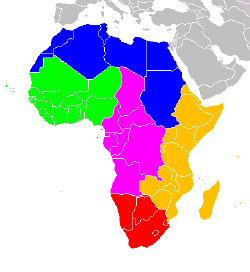 Regions of Africa: ██ Northern Africa ██ Western Africa ██ Middle Africa ██ Eastern Africa ██ Southern Africa |
| Name of region[1] and territory, with flag |
Area (km²) |
Capital | |||
|---|---|---|---|---|---|
| Eastern Africa | |||||
| 27,830 | Bujumbura | ||||
| 2,170 | Moroni | ||||
| 23,000 | Djibouti | ||||
| 121,320 | Asmara | ||||
| 1,127,127 | Addis Ababa | ||||
| 582,650 | Nairobi | ||||
| 587,040 | Antananarivo | ||||
| 118,480 | Lilongwe | ||||
| 2,040 | Port Louis | ||||
| 374 | Mamoudzou | ||||
| 801,590 | Maputo | ||||
| 2,512 | Saint-Denis | ||||
| 26,338 | Kigali | ||||
| 455 | Victoria | ||||
| 637,657 | Mogadishu | ||||
| 619,745 | Juba | ||||
| 945,087 | Dodoma | ||||
| 236,040 | Kampala | ||||
| 752,614 | Lusaka | ||||
| 390,580 | Harare | ||||
| Central Africa | |||||
| 1,246,700 | Luanda | ||||
| 475,440 | Yaoundé | ||||
| 622,984 | Bangui | ||||
| 1,284,000 | N'Djamena | ||||
| 342,000 | Brazzaville | ||||
| 2,345,410 | Kinshasa | ||||
| 28,051 | Malabo | ||||
| 267,667 | Libreville | ||||
| 1,001 | São Tomé | ||||
| Northern Africa | |||||
| 2,381,740 | Algiers | ||||
| 7,492 | Las Palmas de Gran Canaria, Santa Cruz de Tenerife | ||||
| 20 | — | ||||
| 1,001,450 | Cairo | ||||
| 1,759,540 | Tripoli | ||||
| 797 | Funchal | ||||
| 12 | — | ||||
| 446,550 | Rabat | ||||
| 1,861,484 | Khartoum | ||||
| 163,610 | Tunis | ||||
| 266,000 | El Aaiún | ||||
| Southern Africa | |||||
| 600,370 | Gaborone | ||||
| 30,355 | Maseru | ||||
| 825,418 | Windhoek | ||||
| 1,219,912 | Bloemfontein, Cape Town, Pretoria[8] | ||||
| 17,363 | Mbabane | ||||
| Western Africa | |||||
| 112,620 | Porto-Novo | ||||
| 274,200 | Ouagadougou | ||||
| 4,033 | Praia | ||||
| 322,460 | Abidjan,[9] Yamoussoukro | ||||
| 11,300 | Banjul | ||||
| 239,460 | Accra | ||||
| 245,857 | Conakry | ||||
| 36,120 | Bissau | ||||
| 111,370 | Monrovia | ||||
| 1,240,000 | Bamako | ||||
| 1,030,700 | Nouakchott | ||||
| 1,267,000 | Niamey | ||||
| 923,768 | Abuja | ||||
| 410 | Jamestown | ||||
| 196,190 | Dakar | ||||
| 71,740 | Freetown | ||||
| 56,785 | Lomé | ||||
Notes
- ↑ Continental regions as per UN categorizations.
- ↑ The Spanish Canary Islands, of which Las Palmas de Gran Canaria are Santa Cruz de Tenerife are co-capitals, are often considered part of Northern Africa due to their relative proximity to Morocco and Western Sahara.
- ↑ The Spanish exclave of Ceuta is surrounded on land by Morocco in Northern Africa.
- ↑ Egypt is generally considered a transcontinental country in Northern Africa (UN region) and Western Asia; area figures are for African portion only, west of the Suez Canal.
- ↑ The Portuguese Madeira Islands are often considered part of Northern Africa due to their relative proximity to Morocco.
- ↑ The Spanish exclave of Melilla is surrounded on land by Morocco in Northern Africa.
- ↑ The territory of Western Sahara is claimed by the Sahrawi Arab Democratic Republic and Morocco. The SADR is recognized as a sovereign state by the African Union. Morocco claims the entirety of the country as its Southern Provinces. Morocco administers 4/5 of the territory while the SADR controls 1/5. Morocco's annexation of this territory has not been recognized internationally.
- ↑ Bloemfontein is the judicial capital of South Africa, while Cape Town is its legislative seat, and Pretoria is the country's administrative seat.
- ↑ Yamoussoukro is the official capital of Côte d'Ivoire, while Abidjan is the de facto seat.
ReferencesISBN links support NWE through referral fees
- Bohannan, Paul, and Philip Curtin. Africa and Africans, 3rd ed. Prospect Heights, IL: Waveland Press, 1988. ISBN 0881333476
- Clark, J. Desmond. The Prehistory of Africa. Greenwood Press, 1984. ISBN 978-0313242144
- Crowder, Michael. The Story of Nigeria. London: Faber and Faber, 1978. ISBN 978-0571049462
- Curtin, Philip, et al. African History: From Earliest Times to Independence. New York, NY: Addison Wesley Longman, 1995. ISBN 0582050707
- Davidson, Basil. The African Past. Little Brown & Company, 1964. ISBN 978-0316174244
- Khapoya, Vincent B. The African Experience. Pearson, 2012. ISBN 978-0205851713
- Newman, James L. The Peopling of Africa: A Geographic Interpretation. New Haven, CT: Yale University Press, 1995. ISBN 0300060033
- Reader, John. Africa: A Biography of the Continent. New York, NY: Alfred A. Knopf, 1998. ISBN 0679409793
- Schraeder, Peter J. (ed.). Understanding Contemporary Africa. London: Lynne Riener, 2020. ISBN 978-1626378940
External links
All links retrieved June 16, 2023.
- All Africa current news, events and statistics
- Africa BBC News
- African & Middle Eastern Reading Room Library of Congress
- African collections Stanford University Libraries
- The Index on Africa The Norwegian Council for Africa
Credits
New World Encyclopedia writers and editors rewrote and completed the Wikipedia article in accordance with New World Encyclopedia standards. This article abides by terms of the Creative Commons CC-by-sa 3.0 License (CC-by-sa), which may be used and disseminated with proper attribution. Credit is due under the terms of this license that can reference both the New World Encyclopedia contributors and the selfless volunteer contributors of the Wikimedia Foundation. To cite this article click here for a list of acceptable citing formats.The history of earlier contributions by wikipedians is accessible to researchers here:
The history of this article since it was imported to New World Encyclopedia:
Note: Some restrictions may apply to use of individual images which are separately licensed.
